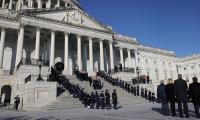Rawalpindi: It was October 8, 2005, a Saturday when an earthquake measuring 7.6 on the Richter scale jolted Bagh, Balakot, Battagram, Muzaffarabad and a number of adjoining areas in AJK along with the twin cities of Islamabad and Rawalpindi at around 08:52 a.m. leaving over 87,000 persons dead and more than 100,000 severely injured.
One who witnessed the day in the northern region of the country in senses can hardly wipe out the memories of the destruction, the earthquake caused. Considered as the worst ever disaster in the region over a hundred years of history, the earthquake rendered about two million people homeless and another four million severely affected in one way or the other.
The earthquake brought the worst ever disaster in the areas stretching from Balakot to Battagram in the northern part of the country and in Bagh, Rawlakot and Muzaffarabad in AJ&K through a violent shaking of the earth’s surface.
The earthquake wiped out a number of towns and villages completely from the face of the earth in northern part of the country. The population in the affected areas including the twin cities of Islamabad and Rawalpindi observed hundreds of aftershocks for over two months after October 8 in 2005.
According to estimates, not less than 200 thousand persons were affected directly and suffered physical losses by the violent shaking of the earth’s crust. October 8, 2005 was a day when the PTCL left working and the mobile phone service was almost of no use due to the heaviest load on the networks at least for five hours after nine in the morning as most of the PTCL and mobile phone consumers were dialing again and again numbers to know the fortunes of their relatives in the aftermath of the earthquake.
The earthquake brought a significant change in the lives of millions of people in the affected areas while convinced the concerned government authorities to devise policies to minimise losses in case of like disasters in future. The severity of the earthquake and the level of destruction it caused can be gauged from the fact that the rehabilitation in one or the other way is still in process in the affected areas.
The earthquake damaged almost the whole infrastructure in the affected areas including Bagh, Rawlakot and Muzaffarabad in AJK and Balakot and Kaghan valley along with a number of other towns in the northern mountainous range of the country.
The first to respond to the event was the general public, as well over 300 relief camps were set up by representatives from among the general public even on the same day, October 8, in the twin cities of Islamabad and Rawalpindi. The earthquake proved the existing health infrastructure at that time a failure exposing incapability of hospitals to manage the extraordinary load of victims though donations from public and NGOs helped the hospitals a lot in managing victims.
Within hours after the quake, the hospitals from Rawalpindi to Jhelum and to Sialkot and even up to Sargodha started receiving heavy burden of victims. The influx of victims reaching allied hospitals in town from the worst affected areas did not lower for nearly two months.
The allied hospitals in town received well over 700 victims just within a single day after the earthquake while in two months, the number of victims who reached allied hospitals from the worst hit areas in need of inward treatment had crossed the figure of 5500. Well over 2000 major surgeries including complex surgeries involving compound fractures (fractures with open wounds) and plastic surgeries were performed at the allied hospitals. It was, however, a pride for general public while mentioning that none of the allied hospitals in the twin cities of Islamabad and Rawalpindi faced shortage of blood pints in the aftermath of earthquake and it was all due to public response. Almost all public sector hospitals in the region provided meals and various types of foods to earthquake victims and their attendants with the help of public donations for over two months after the quake.
According to many health experts, October 8, 2005 earthquake brought a huge disaster but provided opportunity to public to record a rare show of devotion to be remembered for years.
South Asia, with its diverse economies and vibrant cultures, holds a unique position in the global economic framework
SAFA brings together accounting bodies from eight member countries to promote harmonisation of accounting standards
ICAP fosters collaboration for sustainable economies worldwide, empowering individuals and organisations alike
SAFA Conference embodies a collective vision to navigate challenges, unlock opportunities
Minister says Hafeezullah Niazi, father of Hassan Niazi, was certainly going through a difficult time
Judge hears case as none of the suspects and their lawyers appeared in the court







